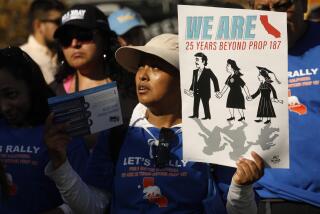Striking a nerve on racism
- Share via
I struck a nerve two weeks ago when I suggested that all Americans, Latinos especially, owe a collective thank you to black people for their struggles for equality.
Recognizing this truth, and teaching our children that black people fighting for their own freedom helped free all of us, I argued, can help combat intolerance in communities where blacks and Latinos live side by side.
I got more than 300 messages, mostly positive. Dozens of black people thanked me for “saying what someone . . . in the Latino community needed to say.”
But others launched into a refrain I hear whenever I write the word “Latino.”
I see it routinely in my e-mail inbox after nearly every column I write.
The gist: Deport illegals, who bring with them nothing but trouble, and this country will be a whole lot better.
Which brings me to another useful lesson to be found in black history.
Until relatively recently, really, it was socially acceptable to express hateful racist stereotypes against black people in popular culture and media.
Jack London was one of America’s most famous writers when Jack Johnson became the first black boxer to win the heavyweight championship in 1908. When London greeted that win by calling for a “great white hope” to vindicate the superiority of the white race, no one boycotted his books or shamed him into an apology. Back then, it was perfectly fine for whites to suggest blacks were inferior.
Casual racism against blacks was so prevalent for so long in America, it survives now in all sorts of strange places. You can rent the DVD for the 1940 comedy “His Girl Friday,” for instance, and suddenly hear a slur for a black child slip into the witty banter between Cary Grant and Rosalind Russell.
Pick up any work of African American fiction written between 1865 and 1965, and you’ll feel the weight of the oppressive racism the novelist Richard Wright described in “Native Son,” a hatred directed at “12 million people . . . [who] constitute a separate nation, stunted, stripped and held captive within this nation. . . .”
It took a lot of blood and tears to cleanse our public discourse of the most overt racism against black people and push it out onto the fringes of American culture.
But today, in this supposedly enlightened age, another form of socially acceptable racism is gaining ground.
The most commonly repeated stereotype in public discourse today, in my humble opinion, is that of the Latino immigrant as a criminal, parasitic and uneducated drain on American society.
Michael Savage routinely gives a more caffeinated version of the hate speech that’s on the airwaves every day. In April, he suggested that Islamic terrorists were using “illegal aliens” to bring swine flu into the U.S. “They are the perfect mules to bring this virus into America,” he said. At other times, he’s said illegal immigrants are “killing our police for sport.”
Now some of you will correctly point out that Savage’s attacks are aimed at illegal immigrants, not all immigrants. In fact, some of you might argue that that’s what makes the stereotype acceptable.
There are an estimated 12 million people living in our country in violation of our immigration laws. If they’ve broken one law, the thinking goes, that makes them lawbreakers by definition, and thus deserving of opprobrium.
No matter that an increasing chunk of that population is made up of people who arrived here as minors, brought in by their parents, or that the vast majority of undocumented immigrants pay taxes and live model lives.
This stereotyped vision of 12 million people, stoked daily by right-wing commentators, has come to taint all immigrants, and all Latinos, really, just by its sheer relentless repetition. And if you don’t believe that’s true, consider what happened to the family of Ana Fernandez, a Salvadoran immigrant killed in last week’s train accident in Washington, D.C.
Fernandez was a legal U.S. resident. Still, according to local media reports, her relatives received hate-filled telephone calls, labeling her as “illegal.”
A hate that doesn’t respect death is a powerful hate.
Even mainstream organizations such as the U.S. Hispanic Chamber of Commerce are subjected to these diatribes. The chamber’s mission is to foster Latino business, and it’s thus inherently conservative. But CNN’s Lou Dobbs has referred to members as advocates for “Mexico’s export of drugs and illegal aliens to the United States.”
It’s become so easy to say these things, no one batted an eyelash when Rush Limbaugh met the Mexican American mayor of Los Angeles in 2007 and said Antonio Villaraigosa looked like “a shoeshine guy.”
It seems to me that this kind of racism is the new, 21st century grandchild of the hatred once publicly directed at blacks.
Yes, according to our laws, all Americans are equal under the law. But we’re now living with 12 million Latino neighbors who are de facto second-class citizens, just as black people were before they won civil rights.
I am not saying that the hatred directed at Latino immigrants is as bad as the anti-black racism that permeated American life for nearly two centuries. Not even close.
I’m also not saying that we should accept an open border.
But finding a solution to the problem isn’t helped by incendiary rhetoric.
The lesson of black history is that institutionalizing the inequality of 12 million of our neighbors and tolerating daily slurs against them is a bad thing for American democracy. Like it or not, immigrants have become a part of our social fabric and it’s our responsibility to treat all of them with basic respect.
Each year we postpone the kind of reform that gives the undocumented a path to legal status, we fall deeper into the well of hatred and racism. The misunderstandings and suspicions between us will only grow.
--
More to Read
Sign up for our Book Club newsletter
Get the latest news, events and more from the Los Angeles Times Book Club, and help us get L.A. reading and talking.
You may occasionally receive promotional content from the Los Angeles Times.











